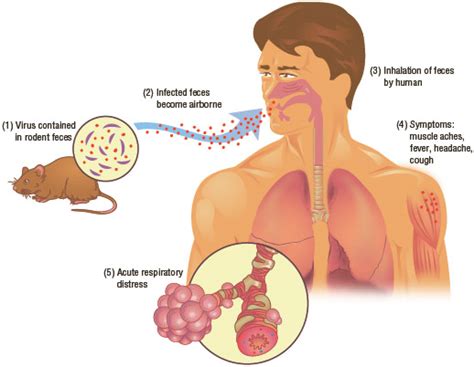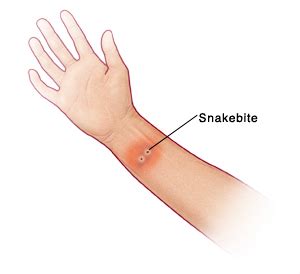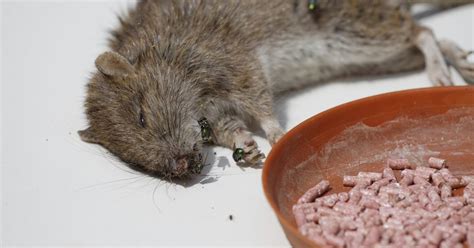
Hantavirus Pulmonary Syndrome
What is Hantavirus Pulmonary Syndrome?
Hantavirus Pulmonary Syndrome, also known as HPS, is a rare but severe respiratory disease caused by infection with hantavirus. It was first recognized in the United States in 1993 and has since been reported in various countries around the world. HPS is often transmitted to humans through contact with infected rodents, particularly deer mice, and their urine, droppings, or saliva. While HPS can be deadly, it is important to note that person-to-person transmission is extremely rare.
Hantavirus belongs to a family of viruses known as Bunyaviridae. There are different types of hantaviruses, and each type is associated with specific rodent species. In North and South America, the most common hantavirus causing HPS is the Sin Nombre virus, which is carried by deer mice. Other hantaviruses found in the Americas include the Andes virus and the New York virus.
When a person becomes infected with hantavirus, the virus enters the body through inhalation of aerosolized particles from rodent urine, droppings, or saliva that have been stirred into the air. This can happen when cleaning up rodent-infested areas, disturbing rodent nests, or simply being in close proximity to infected rodents. Once the virus enters the body, it targets the lungs, causing severe respiratory distress and other flu-like symptoms.
How is Hantavirus Pulmonary Syndrome transmitted?
When it comes to understanding and preventing the spread of Hantavirus Pulmonary Syndrome (HPS), it is crucial to delve into the different modes of transmission. HPS is primarily transmitted to humans through direct or indirect contact with infected rodents. It is important to note that person-to-person transmission of Hantavirus is extremely rare.
Direct transmission occurs when humans come into contact with the bodily fluids, such as urine, saliva, or droppings, of infected rodents. This can happen through inhaling dust contaminated with these fluids or by touching these materials and then touching the eyes, nose, or mouth. It is vital to practice caution when cleaning or working in areas where rodents may have been present and dispose of any rodent waste properly.
Indirect transmission of Hantavirus can also occur through the inhalation of airborne particles. When infected rodents shed the virus, it can become airborne, especially in enclosed spaces with poor ventilation. This can happen when disturbing or cleaning rodent nests or areas where rodents have urinated or droppings are present. Precautions should be taken when entering such areas, such as wearing protective masks and gloves, and ensuring proper ventilation.
Preventing the transmission of Hantavirus Pulmonary Syndrome involves implementing various control measures. These include reducing the risk of rodent infestation in and around homes, storing food properly in sealed containers, and eliminating possible rodent nesting sites. Maintaining cleanliness and hygiene, as well as sealing any potential rodent entry points, are also crucial preventive measures.
While Hantavirus Pulmonary Syndrome can be a serious and potentially fatal illness, understanding its modes of transmission can empower individuals to take the necessary steps to minimize the risk of exposure. By practicing proper hygiene, implementing effective rodent control measures, and being mindful of the potential dangers associated with infected rodents, we can work towards preventing the spread of Hantavirus Pulmonary Syndrome and ensuring the well-being of ourselves and our communities.
Symptoms of Hantavirus Pulmonary Syndrome
Hantavirus Pulmonary Syndrome (HPS) is a severe respiratory disease that is caused by infection with hantavirus. This viral infection is primarily transmitted to humans through contact with infected rodents, specifically deer mice, white-footed mice, and cotton rats. The symptoms of HPS can vary and may initially resemble those of the flu or other respiratory illnesses. However, as the disease progresses, it can lead to severe respiratory distress and, in some cases, can be fatal.
One of the key symptoms of Hantavirus Pulmonary Syndrome is fever. Individuals infected with the hantavirus may experience a sudden onset of high fever, often accompanied by muscle aches and fatigue. This flu-like symptom can make it difficult to distinguish HPS from other common respiratory infections. However, fever is usually persistent in HPS and may last for several days or even weeks.
Another important symptom of HPS is respiratory distress. As the disease progresses, patients may develop shortness of breath, cough, and rapid breathing. This respiratory distress can be severe and may lead to respiratory failure, requiring mechanical ventilation to support breathing. It is crucial to seek medical attention promptly if these symptoms arise, as early diagnosis and treatment can improve the chances of recovery.
In addition to fever and respiratory distress, HPS can also cause other symptoms. These may include headache, dizziness, chills, abdominal pain, nausea, vomiting, and diarrhea. Some individuals may also experience symptoms such as back pain and joint pain. The wide range of symptoms makes it vital to consult a healthcare professional for a proper diagnosis and appropriate treatment.
To diagnose Hantavirus Pulmonary Syndrome, doctors may perform various tests, including blood tests to detect antibodies or genetic material of the hantavirus. In severe cases, imaging tests like chest X-rays may be conducted to assess any lung abnormalities. Treatment for HPS primarily focuses on supportive care, as there is currently no specific antiviral medication available for the disease. Patients may require hospitalization to receive intravenous fluids, supplemental oxygen, and respiratory support.
To prevent the transmission of Hantavirus Pulmonary Syndrome, it is essential to take preventive measures. These include minimizing contact with rodents and their droppings, sealing up any potential entry points in homes and other buildings, keeping food stored properly, and using appropriate protective gear when cleaning rodent-infested areas. Education and awareness about HPS can play a crucial role in preventing its spread and reducing the risk of transmission.
| Symptoms of Hantavirus Pulmonary Syndrome | ||
|---|---|---|
| High fever | Severe respiratory distress | Shortness of breath |
| Cough | Rapid breathing | Headache |
| Dizziness | Chills | Abdominal pain |
| Nausea | Vomiting | Diarrhea |
| Back pain | Joint pain |
Diagnosis and Treatment of Hantavirus Pulmonary Syndrome
Hantavirus Pulmonary Syndrome (HPS) is a rare but potentially life-threatening disease caused by the hantavirus. It is important to diagnose and treat HPS as early as possible to improve the patient’s chances of recovery. The diagnosis of HPS can be challenging due to its nonspecific symptoms and the need for specialized laboratory tests. However, with proper medical evaluation and prompt treatment, the prognosis can be significantly improved.
Diagnosis:
Diagnosing Hantavirus Pulmonary Syndrome requires a combination of clinical evaluation, laboratory tests, and radiological imaging. The most common initial symptoms of HPS include fever, muscle aches, fatigue, and respiratory distress. If a patient presents with these symptoms and has a potential exposure to rodents or their droppings, the healthcare provider should suspect HPS and initiate further diagnostic workup.
Treatment:
There is no specific cure for Hantavirus Pulmonary Syndrome, and treatment mainly focuses on supportive care. Hospitalization is often required for patients with severe respiratory distress or other complications. The healthcare team will closely monitor the patient’s vital signs, oxygen levels, and fluid balance. In severe cases, mechanical ventilation may be necessary to assist breathing. Early recognition and supportive care can significantly improve patient outcomes and reduce the risk of complications.
Prevention and Control:
Preventing Hantavirus Pulmonary Syndrome primarily involves avoiding exposure to rodents and their contaminated environments. It is essential to seal any openings in homes or buildings that can serve as entry points for rodents. Proper sanitation measures should be followed, such as securely storing food, removing rodent nesting sites, and cleaning up rodent droppings using gloves and disinfectants. Education about HPS prevention should be provided to individuals who live or work in high-risk areas.
Prevention and Control of Hantavirus Pulmonary Syndrome
Hantavirus Pulmonary Syndrome (HPS) is a rare but potentially fatal respiratory disease caused by hantavirus infection. It is primarily transmitted to humans through direct or indirect contact with the urine, saliva, or droppings of infected rodents, particularly deer mice. As the name suggests, prevention and control measures are crucial in reducing the risk of HPS. By implementing certain strategies, individuals can minimize their chances of exposure to hantavirus and effectively protect themselves from this dangerous syndrome.
One important step in preventing Hantavirus Pulmonary Syndrome is to eliminate or minimize rodent infestations in and around your living spaces. Sealing cracks and gaps in walls, floors, and foundations can help prevent rodents from entering your home. Additionally, ensuring proper ventilation and cleanliness can reduce the chance of attracting rodents while also creating an inhospitable environment for their survival.
Another key aspect of prevention is practicing safe cleaning methods in areas where rodents have been present. It is important to avoid sweeping or vacuuming areas that may be contaminated with rodent urine, droppings, or nesting materials, as this can aerosolize the virus and make it easier to inhale. Instead, carefully wet the area with a disinfectant or bleach solution and use gloves and masks while cleaning. Afterward, make sure to wash your hands thoroughly with soap and water.
In order to further reduce the risk of HPS, individuals should take precautions when camping or engaging in outdoor activities where rodents may be present. This includes avoiding sleeping directly on the ground, using tents with sealed floors, and keeping food properly stored to prevent attracting rodents to the camping area.
- Seal cracks and gaps in walls, floors, and foundations.
- Ensure proper ventilation and cleanliness.
- Avoid sweeping or vacuuming in potentially contaminated areas.
- Wet the area with a disinfectant or bleach solution before cleaning.
- Use gloves and masks while cleaning.
- Wash your hands thoroughly after cleaning.
- Avoid sleeping directly on the ground while camping.
- Use tents with sealed floors.
- Properly store food to prevent attracting rodents.
By following these preventive measures, individuals can significantly reduce the risk of Hantavirus Pulmonary Syndrome. It is important to stay informed about the disease and take necessary precautions, especially in areas where hantavirus cases have been reported. Remember, prevention is the best defense against HPS, and by adopting these strategies, you can protect yourself and your loved ones from this potentially life-threatening illness.
Frequently Asked Questions
Question 1: What is Hantavirus Pulmonary Syndrome?
Hantavirus Pulmonary Syndrome (HPS) is a rare but serious respiratory disease caused by the hantavirus. It can lead to severe respiratory distress and, in some cases, even death.
Question 2: How is Hantavirus Pulmonary Syndrome transmitted?
Hantavirus Pulmonary Syndrome is primarily transmitted to humans through contact with infected rodents, particularly their urine, feces, or saliva. In rare cases, it can also be transmitted through bites from infected rodents.
Question 3: What are the symptoms of Hantavirus Pulmonary Syndrome?
The symptoms of Hantavirus Pulmonary Syndrome typically start with flu-like symptoms, such as fever, muscle aches, and fatigue. It can progress to severe respiratory symptoms, including coughing, shortness of breath, and fluid buildup in the lungs.
Question 4: How is Hantavirus Pulmonary Syndrome diagnosed and treated?
Hantavirus Pulmonary Syndrome is diagnosed based on a combination of symptoms, exposure history, and laboratory tests. There is no specific treatment for HPS, but medical care and supportive therapy can help manage the symptoms and complications of the disease.
Question 5: How can Hantavirus Pulmonary Syndrome be prevented and controlled?
To prevent and control Hantavirus Pulmonary Syndrome, it is essential to minimize contact with rodents and their droppings. This includes sealing up holes and cracks in buildings, storing food securely, and maintaining proper sanitation. Additionally, avoiding direct contact with rodents and using protective measures, such as gloves and masks, in high-risk areas can help prevent transmission.
Question 6: Is Hantavirus Pulmonary Syndrome contagious from person to person?
No, Hantavirus Pulmonary Syndrome is not believed to be transmitted from person to person. It is primarily spread through contact with infected rodents or their bodily fluids.
Question 7: Are there any vaccines available for Hantavirus Pulmonary Syndrome?
Currently, there are no vaccines available for Hantavirus Pulmonary Syndrome. Prevention efforts mainly focus on avoiding rodent exposure and practicing good hygiene in areas where rodents may be present.


